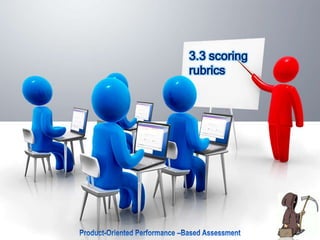scoring rubrics
- 2. Scoring rubrics âĒ - are descriptive scoring schemes that are developed by the teachers or other evaluators to guide the analysis of the products or process of studentsâ efforts. âĒ - are typically employed when a judgement of quality is required and maybe used to evaluate a broad range of projects activities. 3.3 scoring rubrics
- 3. Criteria Setting âĒ The criteria for a scoring rubrics are statements which identify âwhat really countsâ in the final output. 3.3 scoring rubrics
- 4. Major criteria for product assessmentâ âĒ Quality âĒ Creativity âĒ Comprehensiveness âĒ Accuracy âĒ Aesthetics 3.3 scoring rubrics
- 5. Substatements Topic: Three hundred years of Spanish rule in the Philippines âĒ Interrelates the chronological events in an interesting manner. âĒ Identifies the key players in each period of the Spanish rule and the roles that they played. âĒ Succeeds in relating the history of Philippine Spanish rule. 3.3 scoring rubrics
- 6. When are the scoring rubrics an appropriate evaluation technique? âĒ - Grading essays is just one example of performances that may be evaluated using scoring rubrics. 3.3 scoring rubrics
- 7. Scoring rubrics may be used: âĒ Evaluate group activities âĒ Extend projects and oral presentations 3.3 scoring rubrics
- 8. Authentic assessment âĒ Checklist may be used rather than scoring rubrics in the evaluation of essays. 3.3 scoring rubrics
- 9. Checklist âĒ Enumerate a set of desirable characteristics which are actually observed. 3.3 scoring rubrics
- 10. Scoring rubrics âĒ Based on descriptive scales and support the evaluation of the extent to which criteria have met. âĒ âpurpose of assessmentâ 3.3 scoring rubrics
- 11. Benefits of scoring rubrics in the evaluation process âĒ 1. support the examination of the extent to which the specified criteria have been reached. âĒ 2. provide feedback to students concerning how to improve their performances. 3.3 scoring rubrics
- 12. General vs. Task Specific. 3.3 scoring rubrics
- 13. 1 âĒ The identification of the qualities and attributes that the teacher wishes to observe in the studentsâ outputs that would demonstrate their level of proficiency. 2 âĒ determined whether holistic or an analytical rubric would be more appropriate 3 âĒ The identification and definition of the criteria for lowest level of performance. Process of development scoring rubrics 3.3 scoring rubrics
- 14. A note of caution: âĒ It is suggested that each score category should be defined using descriptors of the work rather than value-judgement about the work (Brookhart, 1999) âĒ For example,â studentâs sentences contain no errors in subject-verb agreements,â is preferable over, âstudentâs sentences are goodâ. âĒ 3.3 scoring rubrics
- 15. Kingsoft Office published by www.Kingsoftstore.com @Kingsoft_Office kingsoftstore















